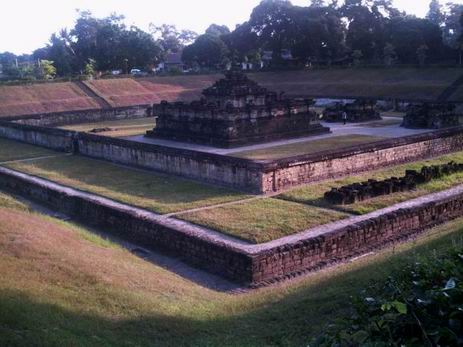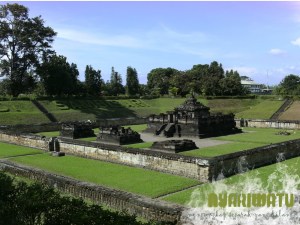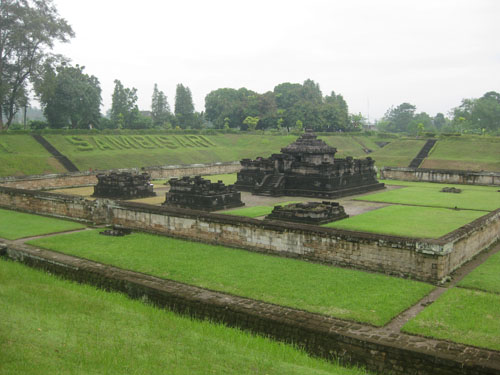Candi Sambisari - Sambisari Temple, The entrance of Merapi Views
Selasa, 29 November 2011
0
komentar

Sambisari temple is situated in the village Sambisari Purwomartani Village, approximately 12 miles from the center of Yogyakarta. Sambisari name is the name of an area with lush paddy fields in the Special Region Yogayakarta where the temple is located. To reach the temple site is located about 12 km to the east of the city of Yogyakarta on the north of the main road between Yogyakarta and Solo, can be reached by bus Yogya-Solo majors until mile 10 where there is a signpost to the temple. From the edge of this great road, the journey is still about 2 miles longer that can be achieved by riding lokasl transportation, such as motorcycle or buggy / sado.

Temple Sambisari discovered around the year 1966 a farmer with a hoe accidentally rammed on top of the temple are buried in the ground peladangannya. but he was astonished when the spade touched a hard object in the form of carved stones are supposed to be part of the ruins of a temple. The name of the farmer is the first time Karyoinangun rediscover a temple complex which was then given the name of the temple Sambisari suitably named the discovery of the temple area. Following up the discovery by the Yogyakarta Archaeological Center conducted research and excavation. From the results of excavations in July 1966 ascertained that the area there is a temple site and expressed as the area of ??cultural asylum. After that began the process of rearrangement of the collapsed ruins of the temple complex due to shocks and buried from the eruption of Mount Merapi material is estimated from geological studies of rocks and soil material stockpile temple complex. In 1987 restoration and re do the reconstruction of the temple complex can be completed with the position of the temple at a depth of 6.5 meters from the ground around the temple Sambisari or often referred to as the underground temple. But some archaeologists estimate the former temple sites exist on the surface of the ground, like the other temples.
Based on geological studies of the rock temple and the land that has been hoard all this, the temple as high as 6 m of material has been buried by the eruption of Mount Merapi in the great in 1006. Temple is a Hindu temple Sambisari of the 10th century which is built by a King of Sanjaya dynasty, with a statue of Shiva as a guru to keep the main hamber

Sambisari temple complex is located adjacent to the building other temples such as Prambanan, Kalasan, Sari. Location Sambisari temple is about 5 km from the temple complex of Prambanan towards the west or about 14 km from the city center to the east. Temple is a Hindu temple wing Sambisari Syiwaistis century-X of the family dynasty is in Sleman district of Yogyakarta province. When excavation of the temple complex Sambisari also found other historical objects, such as jewelry, pottery, gold plate inscription. From the findings obtained Sambisari estimates that the temple was built in 812-838 AD during the reign of King Rakai Garung of the Hindu Kingdom of Mataram (Mataram). Sambisari temple complex condition very well maintained and clean and lots of local tourists, domestic and foreign tourists arrive in droves to visit and become a cultural tour packages to visit other nearby temple complex of Prambanan temples in particular that has been more famous.

Sambisari current temple complex with four buildings seem to be limited by the walls of the temple surrounded with a total area of ??50 x 48m at positions around the land that has been conducted excavations. In the main temple building of the largest has a height of 7.5 meters and a square measuring 15.65 x 13.65 m on the bottom of the temple, the temple is the body size of 5 x5m. It is estimated that the temple complex was not only the area but could be more widespread if held dikwatirkan further excavation but can not deliver water to be discarded because of its position lower than the existing river to the west. The entrance to the temple complex on the fourth side Sambisari square down the stairs.

Sambisari temple is under the surface of the soil as deep as 6.5 meters. When in fact only 7.5 meters high temple. Therefore, when viewed from the side, this temple as if emerging from underground. The bottom of the temple is square with size 13.65 mx 13.65 m. While the body temple measuring 5 m x 5 m. This temple is built in century IX - X M. Since the eruption of Mount Merapi in the year 1006, the area around is covered by materials that originate from the volcano.
The entrance of the temple facing westward. Equipped with a ladder to enter the wing. At the end of the stairs there are reliefs Makara wing supported by two hands kate creatures. The uniqueness of others, this temple has no pillars. So basically the buffer also functions as the pillars of the temple. In this section there is a walkway that surrounds the body temple, and has 12 steps.

On the outside of the body temple there are niches to put the statue. Which still exists today is a statue of Durga in the north, the statue of Ganesha on the east side, and a statue of Agastya in the south. Two other niches that exist on the right and left door, the doorman to the statue of the god, namely Mahakala and Nadisywara. Too bad the statue was not in place anymore. While at the booth in the body of the temple there are statues of Yoni and Linga large.
Besides the main temple, in front of the temple there are three ancillary temples or temple companion. Basically the size of 4.8 mx 4.8 m, with a height of 5 meters. But the ancillary temples had not been restored completely. While there is a fence around the temple of white stone wall measuring 50 mx 48 m. Currently water drainage have been completed, so the temple during the rainy season did not go down the water.

When the excavation was held this Syiwaistis Hindu temple, was also found historical objects. Among some of the pottery, jewelry, metal mirror and a gold plate inscription. Forecasts obtained from it, that Sambisari temple was built in 812-838 AD, when the Hindu Kingdom of Mataram or Mataram was ruled Ancient King Rakai Garung Syailendra Dynasty.
In the main temple entrance facing the west and there are stairs to the shape of his left wing-right side, on top of the stairs leading there are decorative reliefs Makara supported by two hands kate creatures. Unlike the other temples, this temple there is no foundation or pillars of the temple so that the base of the temple is also a pillar of the temple. In the chamber there is a statue of Grand Master and also a statue of Shiva Linga-Yoni in large sizes. The statues are placed on the outside of the body temple there are niches, statues that still exists is a statue of Durga in the north side, Agastya on the south side and on the east side of Ganesha. Being estimated there are two statues of Mahakala and Nadisywara doorman on either side of doors that do not currently exist. While 3 other small temples in front of the temple, the temple ancillary or complementary measuring 4.8 x 4.8 m high on the sides essentially by 5 m. At this time accompanying temple has not been completely reconstructed. The path to the location of the temple complex can be traversed by all types of vehicles, but there is no public transportation that passes through this place is so taken with the motorcycle or buggy / wagon about 2 km from the edge of Yogya-Solo road. To reach the temple site, can be reached by bus Yogya-Solo majors until mile 10 where there is a signpost to the temple.
The uniqueness of Temple
The temple is located about 12 km to the east of the city of Yogyakarta on the north of the main road between Yogyakarta and Solo. Sambisari temple is a very unique temple, the temple was located 6.5 meters below the surface tanah.Itu why, often also referred to as the temple Sambisari underground temple. But some experts estimate arkeo-logy former temple sites exist on the surface of the ground, like the other temples.
This temple was built in the 10th century. Since the eruption of Mount Merapi in the year 1006, the area around is covered by materials that originate from the volcano.
The main temple building of the largest has a height of 7.5 meters and a square measuring 15.65 x 13.65 m on the bottom of the temple, the temple is the body size of 5 x5m.
It is estimated that the temple complex could be more widespread if held further excavation, but it is feared can not deliver water to be discarded because of its position lower than the existing river to the west.
The entrance to the temple complex located on the fourth side Sambisari square down the stairs.
In the main temple, the entrance facing the west and there are stairs to the shape of his left wing-right side, on top of the stairs leading decorative reliefs contained both hands propped Makara kate creatures. Unlike the other temples, this temple there is no foundation or pillars of the temple so that the base of the temple is also a pillar of the temple.
It is estimated that there are two statues of Mahakala and Nadisywara doorman on either side of doors that do not currently exist. While 3 other small temples in front of the temple, the temple ancillary or complementary measuring 4.8 x 4.8 m high on the sides essentially by 5 m. Currently accompanying temple has not been completely reconstructed.
TERIMA KASIH ATAS KUNJUNGAN SAUDARA
Judul: Candi Sambisari - Sambisari Temple, The entrance of Merapi Views
Ditulis oleh Belibuku.web.id
Rating Blog 5 dari 5
Semoga artikel ini bermanfaat bagi saudara. Jika ingin mengutip, baik itu sebagian atau keseluruhan dari isi artikel ini harap menyertakan link dofollow ke http://bukutentang.blogspot.com/2011/11/candi-sambisari-sambisari-temple_29.html. Terima kasih sudah singgah membaca artikel ini.Ditulis oleh Belibuku.web.id
Rating Blog 5 dari 5




0 komentar:
Posting Komentar
terima kasih kunjungannya, jika tak berkeberatan silahkan tinggalkan jejak anda dengan berkomentar di sini..